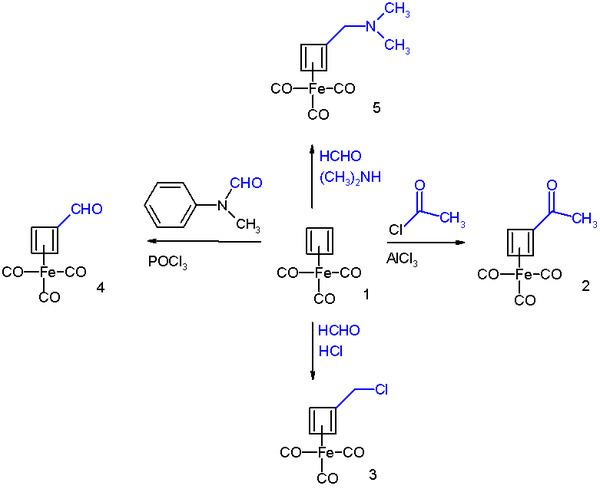Formula (C4H4)Fe(CO)3 | Appearance yellow solid | |
 | ||
Cyclobutadieneiron tricarbonyl or (C4H4)Fe(CO)3 is an organoiron compound with the formula Fe(C4H4)(CO)3. It is a yellow solid that is soluble in organic solvents. It has been used in organic chemistry as a precursor for cyclobutadiene, which is an elusive species in the free state.
Contents
Preparation and structure
It was first prepared in 1965 by Rowland Pettit starting from cyclooctatetraene:
Cyclooctatetraene is chlorinated to the [4.2.0]-bicyclic compound which reacts further with the alkyne dimethyl acetylenedicarboxylate in a Diels-Alder reaction followed by a reverse-DA reaction by pyrolysis at 200 °C releasing cis-dichlorocyclobutene. This compound reacts with di-iron nonacarbonyl (obtained from photolysis of iron pentacarbonyl) to give cyclobutadieneiron tricarbonyl.
The compound is a half sandwich complex. The C-C distances are 1.426 Â.
Properties
Cyclobutadieneiron tricarbonyl displays aromaticity as evidenced by some of its reactions, which can be classified as electrophilic aromatic substitution:
It undergoes Friedel-Crafts acylation with acetyl chloride and aluminium chloride to give the acyl derivative 2, with formaldehyde and hydrochloric acid to the chloromethyl derivative 3, in a Vilsmeier-Haack reaction with N-methylformanilide and phosphorus oxychloride to the formyl 4, and in a Mannich reaction to amine derivative 5.
The reaction mechanism is identical to that of EAS:
Related compounds
Several years before Petit's work, (C4Ph4)Fe(CO)3 had been prepared from the reaction of iron carbonyl and diphenylacetylene.
